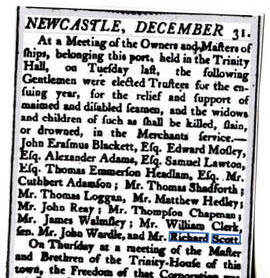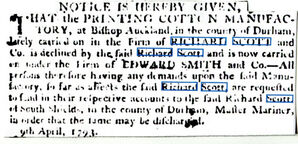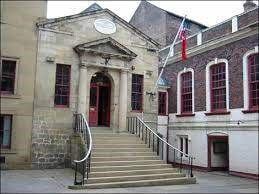
POSTS can now be found under PROJECTS.
| PART 2 > |
PART 1
06 NOVEMBER 2021

INTRODUCTION
On my website, I have started writing-up my research, relating to the lives of my direct ancestors, James Evans (1715-1800) and James Evans (1750-1839), completing to date, two of the parts. Part 2A concluded with a reference to James Evans the Elder's sponsorship of his son James Evans' indenture with Richard Scott; his association with the Evans father and son is of some significance to their lives. However, Richard Scott, a fascinating local figure with a life story worthy of a separate post.
James Evans Jnr.'s Apprenticeship
He was apprenticed in early 1771 to Richard Scott of South Shields but by the end of the year there was a concern about the validity of James Evans junior's actual indenture.
27 December 1771
...Ordered that notice be sent to James Evans of South Shields apprentice to Richard Scott that the Company intend to oppose his freedom and that the money be paid for inrolling his indenture will be returned. And the reason for such opposition is because Richard Scott does not reside in Newcastle and has not licence to settle in South Shields. (1)
Presumably the matter must have been resolved as the apprenticeship was completed and a sum of £3 2s 2½d (approx £560 at today's value) was paid for his release. The Shipwrights may well have had cause for concern as Richard Scott was not a Shipwright; he was a Master Mariner, Shipowner, Ship Trader, and entrepreneur. He also most likely worked in a supervisory capacity in James Evans the Elder's Market Place Dock where his father John Scott as a shipwright may also have been employed.
The fact that James Evans Jnr was indentured to him concealed the more likely fact, that James Evans the Elder, wanted to self-indenture his son which he did under the cover of Richard Scott who was not an owner of a shipyard.
It was to Richard Scott that his brother Thomas Scott (1752-1831) was also indentured on the 29th September 1766. John Scott (1715-1790), their father a mariner stood in surety with the sum of £2 16s 2d paid for his release on the 27th December 1773. (2)
Richard Scott: Master Mariner
Richard was a Master Mariner on at least one of James Evans the Elder's ships, ''Kitty'' which in 1775 in Lloyd's register is shown as having James Evans as owner with the location of the ship in North England. Records of ships prior to 1788 are difficult to find.
''The Kitty'' of this port, Richard Scott, master arrived yesterday from Greenland with four sizeable fish (whale): but the crew left her to avoid being pressed. (3)
It is fascinating to recall the terror sailors had in being impressed to join Royal Navy ships and a credit to Richard Scott that he prevented his seaman from being targeted. Not so, in the case of another ship arriving in Newcastle on the same day.
''The Noble Ann, of this port, Erasmus Roberts master also arrived from Greenland, a successful ship; but the impress boats attempting to board her, they ran her out to sea. and the two tenders and a cutter are gone in pursuit of her.''(4)
Richard Scott: Shipping Trader
This was to some extent feasible as Richard Scott did have an interest in the construction of ships as borne out by the following advertisements:

'Leander' was built by Thomas Hearn in North Shields and launched at his yard in 1795 and as said above purchased by The Royal Navy in 1797. Richard Scott had presumably negotiated a contract whereby he sold the stores and parts of the vessel not required by the Royal Navy.
'Leander' was subsequently converted into a bomb-vessel and renamed as 'HMS Strombolo' participating in the capture of Malta in 1800. Surplus to requirements by 1802, she was laid-up in 1802 and broken up in 1809.

(6) The 'Robert & Sally' was built in South Shields by William Gilley, one of eight ships built at his yard between 1787 and 1791. Bankrupt in 1791, his yard was advertised :- To Let. Commodious Yard and Landing at South Shields lately in the occupation of William Gilley, Shipbuilder, together with a Dwelling-house, Blacksmith's Shop, and a Warehouse (7) To date, I have been unable to find any further records.
Trinity House
By 1798, Richard Scott was a leading Master Mariner and Shipowner and member of a significant group of shipowners and masters including John Wardle also of South Shields.

(8) See notes in References
Biography of Richard Scott
He was born in 1746, the son of Barbary Sadler (-1756) and John Scott, and baptised at St Hilda's Church, South Shields on the 12th August. When he was aged 32yrs in 1778, he married Hannah Crozier (1744-1816) also at St Hilda's Church.
His family life was based in in South Shields although he would have been away from the town during his lengthy sea voyages. In his later years he leased from the Dean and Chapter at Durham a farm in Harton (Harton House Farm) where he died in 1804. Harton was a separate township not amalgamating into a greater South Shields until the mid-nineteenth century.
Hannah and Richard were parents to six children all of whom were baptised at St Hilda's Church in South Shields and when they died, with one possible exception, interred in the family grave in the adjoining graveyard.
Sarah Scott baptised 27 June 1780-buried 8 March 1801
Margaret Scott baptised 8 March 1782-buried 1 November 1802
Hannah Scott baptised June 1784
Richard Scott baptised 12 Oct 1785-buried 23 Feb 1786
Richard Scott baptised 12 Dec 1786-buried 7 June 1787
John Scott baptised 28 June 1788-buried 1851
Two of the children died in infancy whilst Sarah and Margaret died shortly before reaching the age of twenty-one years. This is significant as both were beneficiaries in their grandfather, John Scott's will of 1784 proved on his death in 1790. He paid for their education and they both would have received £50 if they had survived for a few more months. It is rather ominous that both sisters died within months of attaining the age of twenty-one years.
Richard Scott: Entrepreneur/speculator
He had at least one business venture outside of South Shields which was at Bishop Auckland as that of owner of a Printing Cotton Manufacturer factory.

NOTICE IS HEREBY GIVEN, That the PRINTING COTTON MANUFACTURORY in Bishop Auckland in the county of Durham, duly carried on the Firm of RICHARD .SCOTT and Co. dad is now declined by the said Richard Scott, and is now carried out by the firm of EDWARD SMITH and Co. All persons therefore having any demands upon the said manufactory Richard Scott, are requested to send in their respective accounts to the said Richard Scott of South Shields in the county of Durham , Master Mariner, in order that the time may be discharged (9th April, 1793).
Rejected Membership of South Shields Library
Since transcribing the minutes (which I started in 2011) of two early South Shields libraries, the Free Library at the Lawe (1788-1802) and the Exchange Subscription Room in the Town Hall in the Market Place (1800 -1855), I have worked on a profile of the membership. In 1800, Richard Scott's application for membership of the latter was rejected in 1800.
Meeting: -26th May 1800
Chair: - Joshua Bulmer
Present: -16 Members
Admitted by Secret Ballot:- Messrs Francis Blackett, Charles Cockerill, Thomas Forrest, William Harrison, James Luke, John Marshall, William Masterman, Thomas Robertson, John Roxby, John Siddall, Robert Stephenson, Robert Thompson, Edward Walker, Matthew Wardle & Thomas M. Winterbottom
Rejected by Secret Ballot: - Messrs Isaac Cookson & Richard Scott
According to the minutes only two applicants were refused membership during the 55 years of operation. No reason was given for the rejections; Isaac Cookson was a premier glass manufacturer in South Shields and like the members listed, a significant member of South Shields society in the late eighteenth and early nineteenth centuries. Conversely, almost two years later, James Evans the younger refused to accept his nomination for membership. With no reason given in the minutes, perhaps he objected to the rejection of his father's associate?
Meeting: -12th May 1802 Admitted as Members: - Mr Joseph Anderson & Mr Thomas Reed Give notice to discontinue:-Messrs. Lee, William Smith & Richard Bulmer James Evans, W R Stephenson also declined to become members.
NB. Dr Thomas Masterman Winterbottom (1766-1859) was one of the most prominent members of South Shields society; founder of the Marine School, physician, philanthropist, and abolitionist who described African Trypanosomiasis (Sleeping sickness caused by parasites) whilst practising in Sierra Leone and donating the land for Westoe Cemetery. Some rejection. However, it was Dr Winterbottom who was a witness to Richard Scott's will of 1804!
Death and Burial
Richard SCOTT, gentleman, of Harton house in the county of Durham [South Shields, County Durham]
He died on the 28th August 1805 at his home 'Harton House' in Harton, South Shields and he was interred in St Hilda's Churchyard on the 30th August. There is no physical evidence of his burial (a grave where nine family members were interred) or a transcription of the gravestone inscription. Sadly, this is the situation for the many thousands of the interments in this churchyard (my on-going research St Hilda's Churchyard from 2005 to be posted in 2022).
Will
I have partly transcribed Richard Scott's will as it provides an insight into his financial status at death, to the life of his son, John Scott and that of his friend, Robert Whinnam on Wearside.
'This is the last Will and Testament of me, Richard Scott of Harton House in the County of Durham, gentleman, made this fourth day of August in the Year one thousand eight hundred and five,- I order all my just Debts, Funeral Expenses and the charges of proving this my Will to be paid within a reasonable time after my decease, And I charge and make chargeable all my personal Estate (except my House at Harton, my Household Furniture Plate Linen and China, and except my Ships and Parts of Ships) with the Payment thereof, and of one half the Legacy hereinafter given -And as to the annuity hereinafter given and limited and the remaining half of the said Legacy I charge and make liable only my leasehold lands at Harton and my leasehold premises at South Shields in the said County of Durham with the Payment of the same, with power of Entry and Distress in the Case of Non Payment the said Annuity Space of twenty days, next after the same shall be due:-
I give, bequeath, and grant unto my dear wife Hannah Scott, one clear annuity or yearly Rent charge of One hundred and fifty Pounds for and during such part of her natural life, as she shall continue my Widow.
I give and bequeath unto my Dear Daughter Hannah Scott the Legacy of Two thousand pounds, and order and direct One thousand Pounds, Part thereof to be paid immediately upon my decease and the remaining part thereof upon the Death or future marriage of my said Wife. I give devise and bequeath unto my dear Daughter Hannah Scott the Legacy of all my leasehold lands and Tenements at Harton and South Shields aforesaid or elsewhere for the present or any future to be renewed leases thereof, and which maybe in existence at the time of my death, and all my estate and Interest therein, and my ships and Parts of Ships and insurances thereon, (being chargeable with the Debts against the same). Money in the Funds, and Securities for Money, Debts and all other my Household Furniture, Goods and Chattels, Real and Personal Estate and Effects whatsoever and wheresoever to my dear Son John Scott and my friend Robert Whinnam of Monkwearmouth Shore in the said County of Durham, Shipbuilder. to permit and suffer my wife to hold, use and enjoy the dwelling house at Harton wherein I now reside with its immediate appurtenances with the gardens adjoining, and also all my Household Furniture, Plate, Linen for and during her natural life or widowhood, and without prejudice.
If the said Robert Whinnam during the minority of my said son think it is advisable to let my Farm at Harton, with the Farm yard, Stables, Barnes and Byers and other appurtenances thereto belonging it may be lawful so for any term not exceeding four years taking the most improved rent, and upon a good and improveable Scheme of Husbandry, but it shall not be lawful to let any other Part of of my messsuagess or Tenements, on Leases, during my said Son's Minority. And in case of letting the Farm at Harton, I direct my Executors to convert the Cottage House at Harton into a suitable farmhouse at a moderate expense, and for that Purpose, to call in and apply so much of my Principal Monies, as may be requisite:
I appoint my said dear son John Scott, and the said Robert Whinnam Executors of this my Will Witnesses: Elizabeth Chapman, William Blackburn Public Notarary and Thomas M. Winterbottom MD. (10)
Probate
This was granted on the 21st October 1805 and then regranted on 28 April 1826 by which time Richard's son John Scott had eventually taken control of his father's estate with the value then given as £10,000. John Scott lived in Bishopwearmouth for most of his adult life. He and his wife were interred in the family grave in St Hilda's Churchyard.
Harton House Farm
'my wife to hold, use and enjoy the dwelling house at Harton, wherein I now reside together with the immediate appurtances and two gardens'.
I have written for the Archive 'The Yeoman Family of Harton: Poignant Memorial to a family beset by Tragedy (1781-1803)' which relates to the prior occupants of Harton House Farm who would have built the home and developed the gardens. Ann Yeoman died in 1803 by which time she lived at her other home in Westoe, relinquishing the family home, Harton House Farm during the previous decade.
Comments
In the concluding part (Part 2), I have written about the relocation by the surviving members of Richard Scott's family, his wife Hannah Scott and children Hannah and John Scott, to Bishopwearmouth on the south bank of the River Wear, now Sunderland.
Also, I have delved into the life of Robert Whinnam held in such high esteem by Richard Scott, he was a wealthy and prominent shipowner who lived in Monkwearmouth on the north side of the Wear and Whitburn. The connection to South Shields shipbuilders Horn, Nicholson and Blenkinsop is relevant to the life of the Scott family so I have also written about their operation on the River Tyne. together with concluding comments.
REFERENCES
1. The Records of the Company of Shipwrights of Newcastle upon Tyne, 1622-1967,' volume 184, edited by David Rowe & published by The Surtees Society in 1970 (p.64).
2. ditto (p.265)
3. (Newcastle Courant-Saturday 31 July 1779)
4. (Newcastle Courant-Saturday 31 July 1779)
5. (Newcastle Courant - Saturday 06 May 1797)
6. (Newcastle Courant - Saturday 10 November 1798)
7. Notes on The History of Shipbuilding in South Shields 1746-1946 by Amy C Flagg -1979
Tyne Built Ships: A History of Tyne Shipbuilders and the Ships that they Built Shipping and Shipbuilding Research Trust (SSRT)
8. Newcastle Courant - Saturday 31 December 1796
9. Newcastle Courant - Saturday 13 April 1793
10. Wills-Durham Wills and Inventories (Family Search)
Trinity House

The 'Guild of the Blessed Trinity of Newcastle upon Tyne' emerged in the late 15th century, and was formally constituted on 4 January 1505 when it obtained an area of land close to the river on which to build a chapel, meeting room and lodgings for mariners which was secured by the rent of one red rose, payable annually on Midsummer's Day. The corporation as it was eventually known, was given the responsibility for improving the condition of the River tyne so that it became a navigable river. A Royal Charter was received from King Henry VIII in 1536 stipulating that towers with lighting should be built on the north side of the river to aid navigation (Wikipedia/ Co. Curate). Tours of the building are available by prior booking.

For further information: The Birth and History of Trinity House by David R Moir-1958